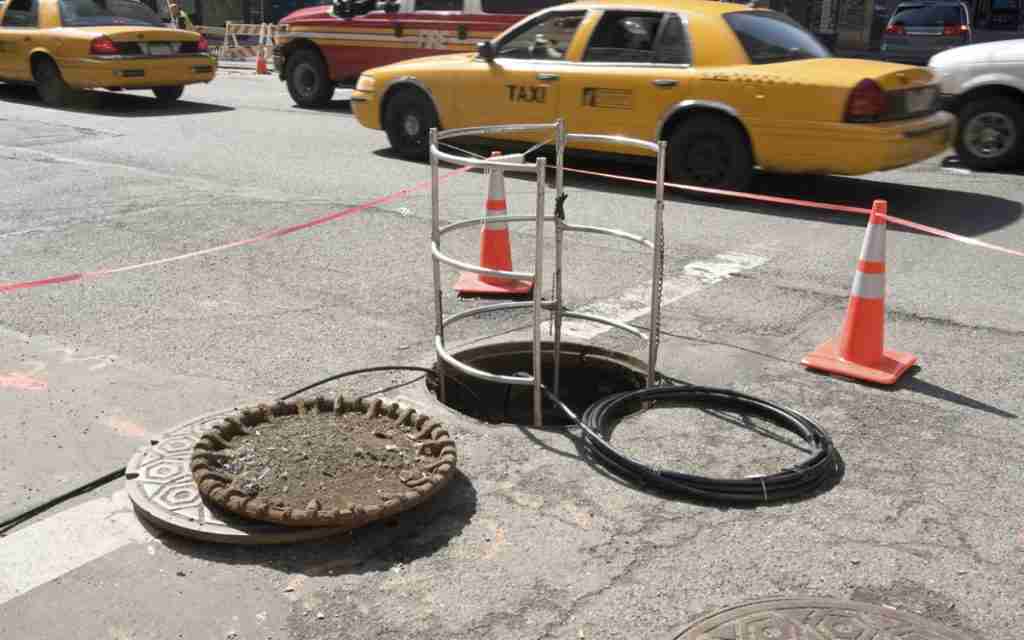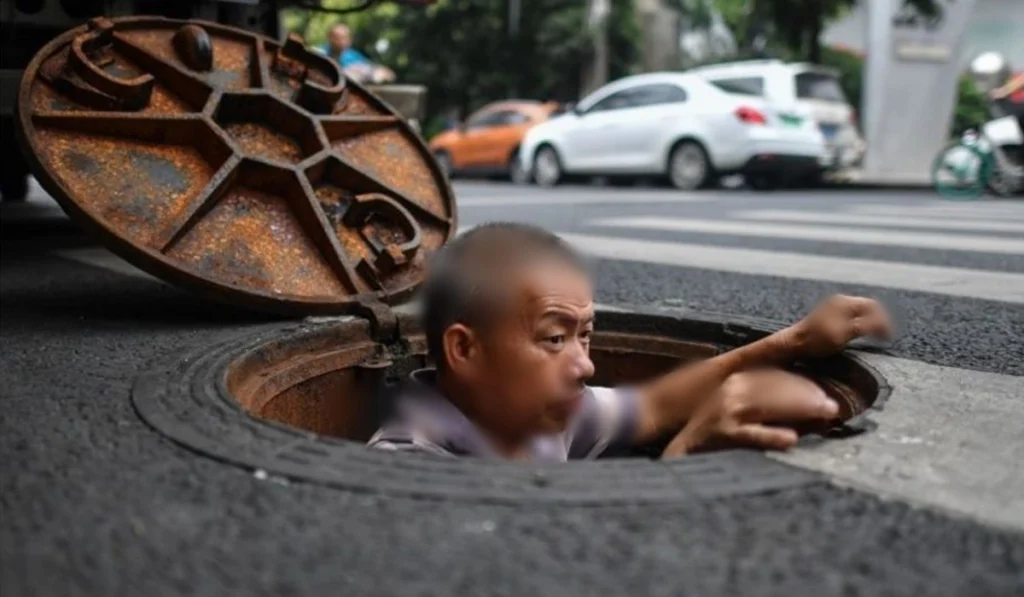Manhole covers are usually round for practical and technical reasons. The circular shape ensures safety and efficiency in urban infrastructure. A round cover cannot fall through its opening, unlike square or rectangular shapes. This feature makes it ideal for preventing accidents.
Key Points:- It cannot fall through its opening.
- Support heavy loads such as – Bus, Trucks and Other heavy Vehicles.
- Good option for city planning.
- Workers can easily dive into the seivers through these manholes.
The even geometry of a circle distributes weight evenly, even they are around 110 kgs, still supporting heavy loads such as vehicles. Round covers are also easier to handle, rotate, and align, simplifying their use for workers accessing underground utilities like water and sewer systems.
The shape is cost-effective for manufacturing and transport, making it the preferred choice. This design balances simplicity and functionality, demonstrating its continued importance in city planning.
Understanding Manhole Covers:
Before we dive into the technical reasons behind the shape of manhole covers, let’s first understand what they are and why they exist?

Manhole covers serve an essential role in modern cities, providing access to underground utilities such as sewers, water lines, electrical cables, and gas pipes. They protect both the public and underground infrastructure from accidents and damage.
Manhole covers come in various shapes, but round covers dominate the global landscape. It’s not because engineers have always favored circles, but rather because circles provide several practical advantages.
These advantages extend beyond aesthetics or tradition—they are deeply rooted in safety, efficiency, cost-effectiveness, and structural integrity.
Geometry: A Circle Cannot Fall In
1. Geometric Simplicity
The primary reason manhole covers are round lies in their geometric simplicity. A circular cover cannot fall into its corresponding opening, no matter how it is positioned or rotated. This makes it a highly reliable and practical choice for covering manholes.
2. Why Other Shapes Fall Through
To illustrate this, consider a square manhole cover. The diagonal of a square is longer than its sides, meaning if you position it at an angle, the diagonal could easily slip through the opening. This poses a serious safety risk, especially in environments where utility workers frequently handle these covers.
3. Consistent Radius Advantage
In contrast, a circle has a consistent distance from its center to any point on its edge, known as the radius. This uniformity ensures that a circular cover cannot fall through its opening, no matter how it is tilted or rotated.
This inherent safety feature, combined with its simplicity and functionality, makes the round shape an ideal choice for manhole covers.
Safety: No Sharp Edges or Risk of Slippage

1. Eliminating Sharp Edges
Safety is a critical consideration in designing infrastructure, and round manhole covers excel in this aspect.
Unlike square or rectangular alternatives, circular covers have no corners or sharp edges. This reduces potential hazards for pedestrians and vehicles, ensuring a safer environment on busy streets and in urban areas.
2. Resistance to Dislodgement
Round manhole covers are less likely to be dislodged by the weight of traffic, providing enhanced stability. Their design ensures they remain securely in place, even under heavy loads, such as buses or trucks passing overhead. This stability minimizes the chance of accidents caused by loose or shifted covers.
3. Ease of Handling and Safety for Workers
A circular shape offers additional safety advantages for maintenance workers.
Round covers can be rolled into place with minimal effort, reducing the risk of strain or injury during handling. The smooth, edge-free design also lowers the risk of tripping or contact injuries. Together, these features make round manhole covers the safest and most practical option for public infrastructure.
Structural Integrity: The Strength of a Circle
1. Even Pressure Distribution
A circle is renowned for its ability to distribute pressure evenly across its surface, making it one of the strongest geometric shapes.
This characteristic is crucial for manhole covers, as it allows them to withstand immense stress from the weight of vehicles and the earth beneath. The circular design ensures that no single point bears excess pressure, preventing deformation or damage.
2. Weakness of Other Shapes
In comparison, square or rectangular manhole covers are less efficient under heavy loads.
The corners of these shapes are particularly vulnerable to stress, making them prone to cracking or breaking over time. This not only compromises safety but also increases the frequency of maintenance and replacement, adding to infrastructure costs.
3. Durability and Reliability
The structural integrity provided by the circular design extends the lifespan of manhole covers, ensuring they remain reliable even under demanding conditions.
Their ability to handle stress without cracking or breaking makes round covers a superior choice, combining durability with practical functionality for urban and industrial environments.
Ease of Manufacturing: Simplicity Equals Efficiency
1. Streamlined Production Process
Round manhole covers are significantly easier to manufacture compared to their square or rectangular counterparts.
The process of casting or molding a circular cover is straightforward, eliminating the need to account for angles, edges, or corners. This simplicity not only saves time but also reduces material waste, making production more efficient.
2. Cost-Effectiveness
The absence of complex shapes in round designs leads to lower production costs.
The standardized circular shape allows manufacturers to employ mass production techniques, taking advantage of economies of scale. This is particularly beneficial in large cities, where the demand for manhole covers is high, and cost efficiency is a top priority.
3. Reduced Waste and Time
Circular designs streamline the entire manufacturing process, from shaping to finishing.
With no intricate edges to perfect, round covers require fewer steps to produce, further speeding up production. This efficiency ensures that resources are used effectively, reinforcing the practicality of round manhole covers for widespread use.
Easy Handling: Rolling and Moving Made Simple
1. Effortless Mobility
Manhole covers are heavy, often exceeding 100 kilograms, making their movement a challenging task for workers.
Round covers provide a practical solution by allowing them to be rolled along the ground, significantly easing the process. This feature minimizes the need for lifting, reducing physical strain and making the task safer for maintenance crews.
2. Reduced Risk of Injury

The ability to roll a round manhole cover not only simplifies transportation but also lowers the risk of injuries caused by improper lifting or overexertion. Workers can efficiently move these covers with minimal effort, ensuring both safety and efficiency during routine maintenance or replacements.
3. Limitations of Other Shapes
In contrast, square or rectangular covers lack the rolling advantage. These shapes require lifting or dragging, increasing the physical effort and potential hazards associated with their handling.
The inherent ease of movement provided by the round design highlights its practicality, making it the preferred choice for manhole covers in urban and industrial environments.
Ease of Installation: No Alignment Needed
1. Hassle-Free Placement
Round manhole covers offer a significant advantage when it comes to installation: they require no specific alignment.
Regardless of how they are positioned, a circular cover will always fit properly over its opening, making the process quick and straightforward. This feature is especially beneficial during routine maintenance or emergency repairs when time is critical.
2. Avoiding Alignment Challenges
In contrast, square and rectangular covers demand precise alignment with the edges of the opening to ensure a secure fit. This additional step not only complicates the process but also increases the time and effort needed for installation. Improper alignment can result in gaps or instability, posing potential safety risks.
3. Time and Labor Efficiency
The simplicity of round covers reduces the time and labor required for installation, translating into lower maintenance costs.
Workers can easily position the cover without the need for adjustments, ensuring both safety and efficiency. This ease of installation makes round manhole covers a practical choice for cities where frequent maintenance is necessary.
Versatility in Maintenance and Access
1. Ease of Rotation
Round manhole covers offer unmatched versatility during maintenance or repair work.
Utility workers can effortlessly rotate the cover to align it with the opening, providing easy access from any angle. This rotational freedom ensures smooth operations without the need for precise positioning, streamlining the maintenance process.
2. Minimized Disruptions
The round shape eliminates concerns about the cover falling through the hole or misaligning during handling.
This reduces potential hazards and ensures quicker access to underground systems. By minimizing disruptions to traffic and pedestrians, round manhole covers contribute to safer and more efficient maintenance in busy urban environments.
3. Enhanced Efficiency
The ability to quickly adjust and reposition a round cover reduces downtime during repairs or inspections.
This efficiency allows workers to complete tasks faster, ensuring the seamless operation of critical utilities. The versatility of round manhole covers is a key factor in maintaining the functionality of urban infrastructure while minimizing inconvenience.
Cost-Effectiveness: Saving Material and Resources
Cost is always a crucial factor in any design decision. Round manhole covers are more economical to produce than square or rectangular covers, mainly due to their geometric properties.
The circular shape requires less material to manufacture, as the surface area of a round cover is smaller compared to a square cover of the same size. This reduction in material usage leads to cost savings for manufacturers and, ultimately, for cities and municipalities that need to purchase and maintain these covers.
Additionally, lighter covers are easier to transport and require less energy to move, which further reduces operational costs.
Environmental Considerations: Sustainable Design
1. Material Efficiency
Round manhole covers are designed with sustainability in mind. Their smaller surface area compared to square or rectangular covers means they require less material during production.
By using fewer resources, the manufacturing process minimizes waste and reduces the environmental impact, aligning with modern goals of sustainable urban development.
2. Extended Lifespan
The inherent durability and long lifespan of round covers contribute significantly to sustainability.
With fewer replacements needed over time, resource-intensive manufacturing and transportation processes are reduced. This longevity ensures that cities can maintain their infrastructure while minimizing their environmental footprint.
3. Lower Environmental Impact
By prioritizing designs that are both functional and efficient, round manhole covers support the creation of eco-friendly urban systems. Their combination of material efficiency and durability demonstrates how small design choices can lead to significant environmental benefits in the long term.
Historical Context: The Evolution of Manhole Cover Design
The design of manhole covers has evolved over time, influenced by changes in urban infrastructure and engineering practices.
Early manhole covers were made from wood or other materials, and the shape of the cover was determined by practical considerations of the time. Over time, engineers realized that round covers offered the best combination of safety, strength, and ease of manufacturing.
As cities grew and the demand for reliable underground utilities increased, the need for standardized manhole covers became evident. The round shape was eventually adopted as the most efficient solution, and it has remained the preferred design ever since.
Global Variations: Alternatives to Round Manhole Covers
While round manhole covers are the most common design worldwide, some regions have experimented with different shapes due to specific engineering needs or cultural preferences.
Triangular, square, and rectangular covers can be found in certain locations, particularly where unique structural challenges exist. However, these alternative shapes rarely offer the same benefits as round covers. The practical advantages of round covers—such as safety, ease of handling, and structural integrity—have made them the global standard.
In most cases, the drawbacks of alternative shapes outweigh the benefits, which is why round manhole covers remain the go-to design in most cities.
Frequently Asked Questions:
Round covers are far simpler to handle and move since they can be rolled, unlike square covers, which are much harder to shift and maneuver.
Tampering with or removing manhole covers is both illegal and highly dangerous.
Round manhole covers are simpler to handle than those with irregular shapes. Their symmetrical design makes it easier for workers to align and position them, minimizing the risk of errors or injuries during installation and maintenance.







